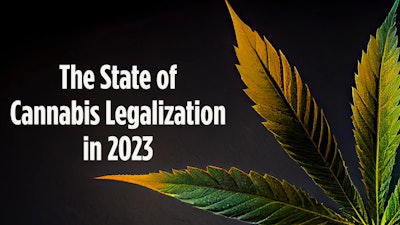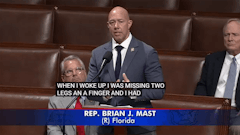
It was big news last fall when President Joe Biden pardoned federal offenders who had been charged and convicted of federal cannabis possession.
For over 50 years, since President Richard Nixon signed the 1970 Controlled Substances Act, cannabis has been a Schedule I federally controlled illegal drug, classified just like heroin and LSD. Yet, Biden’s pardon proclamation did not make cannabis federally legal. However, tucked into Biden’s 2022 executive order was something no president to date has done: Biden directed the Secretary of Health and Human Services and the Attorney General to “review” the legal classification of cannabis.
No formal announcement on the status of that review has been made since then.
Just two months after issuing the 2022 pardon proclamation, Biden also ramped up cannabis research expansion by signing into law the 2022 Medical Marijuana and Cannabidiol Research Expansion Act. This legislation opened up even more federal research by finally streamlining the approval process for the federal scientific studies. For the first time in American history, there now exists a cannabis medical study law that requires the U.S. attorney general to review medical study proposals within a 60-day period or request that applicants provide additional information. As of yet, though, there’s no real sense of the impact this legislation has had on actual medical cannabis research.
Before these presidential moves, the medical research of cannabis’s health benefits was almost solely the province of the states. In fact, Pennsylvania, which legislatively legalized in 2016, was the first state to require medical cannabis research as part of its medical legalization regime. Since then, other states like California and Colorado have established state-sponsored research programs, but Pennsylvania remains the nation’s first to select and pair state universities with cannabis producers to collect data and study cannabis’s efficacy.
Looking back at Yo-Yo’ing of Legalization Efforts in the U.S. in the Last Three Years
We have emerged from COVID isolation. Our federal government has not yet changed its laws to make cannabis federally legal. Federally insured national and international banks will still not offer financial services to those in the cannabis business for fear of federal money laundering exposure (that is, facilitating trafficking in illegal controlled substances). Plus, there continue to be significant immigration consequences for green card holders who work for or own state-legal cannabis businesses. Federal courts, citing cannabis’ federal illegality, continue to deny U.S. citizenship.
Even so, legalization activity continues across the states with some amount of backsliding in a few Republican-controlled states.
In the November presidential 2020 election, five states had initiatives to legalize cannabis on the ballot: Arizona, Mississippi, Montana, New Jersey, and South Dakota. “Cannabis won decisively.” Arizona, Montana and Montana added recreational legalization to already existing medical regimes and Missouri legalized medical the medical use or marijuana. South Dakota voters legalized both but only medical legalization. withstood state lawmaker legal challenges.
After the November 2020 Election through May 2022
After the cannabis legalization landslide of November 2020 election and through May 2022, five more states adopted or expanded marijuana legalization. In March 2021, New York legalized adult recreational use. Then, in April 2021, New Mexico legalized adult recreational marijuana. That same month, Virginia’s legalization of adult recreational marijuana took hold. Later in 2021, specifically in June 2021, adult recreational use became legal in Connecticut. And in May of last year, 2022, Rhode Island legalized adult recreational use.
The November 2022 Elections & Backsliding on Legalization
Last fall, in the November 2022 (off presidential season) election, five states placed voter initiatives to legalize marijuana on the ballot. Only 2 out of the 5 states legalization efforts succeeded: Maryland and Missouri legalized adult recreational use. However, Arkansas, North Dakota, and South Dakota voted against adult recreational legalization. Given the losses, TIME called the November 2022 election a “bad night for marijuana.” It was not a good one.
This retrenchment in those Republican-led states corresponded with the increase of a “more anti-vocal political establishment” to include those seeking higher political offices. Cannabis legalization (which had been on an apparently unstoppable state-legalization trajectory) appears to have been swept up with other polarizing, social issues to include women’s reproductive freedom and the teaching of diversity, equity and inclusion content in America’s schools.
Retrenchment is still in play. Just three months ago, in a special election held in March 2023, in the medically legal wild west state of Oklahoma, a state with no caps or limits to licensure, Oklahomans voted down adult recreational legalization with a margin of 62-38%.
Newest States to Expand Legalization
But legalization backsliding is not taking hold everywhere. Kentucky, a state with an overwhelming Republican General Assembly but which has a Democratic governor, legalized medical marijuana at the end of March 2023. Gov. Andy Beshear, had done something novel in November 2022, becoming the first state to legalize medical marijuana by executive order of the governor. The sky in Kentucky did not fall as a result and months later, the Republican-controlled General Assembly, passed legislation endorsing the governor’s executive action. Bashear touted the effort as one showing that in his state “…both Democrats and Republicans…people coming together [did] what’s right for the people of Kentucky.”
Weeks ago, Minnesota joined the adult recreation legalization column. The Minnesota Senate on May 20, 2023, passed a bill that legalized recreational marijuana use, making it legal for Minnesotans to “possess, use and grow marijuana at home” and Governor Tim Waltz signed it into law on May 30, 2023. Under the measure effective Aug. 1, adults (age 21+) will be permitted to use, possess and transport cannabis flower product up to 2 pounds at home and 2 ounces in public.
How Many States and U.S. Territories Have Some Degree of Legalization?
With so much activity, the state legalization count (and degrees of legalization) and the precise total numbers are always changing. Here is the count as of today:
- Recreationally Legal: 23 states
- Exclusively Legal for Medical Use: 15 states
- Severely Limited Access: 9 states.

There are Still Three States and One U.S. Territory Where Cannabis Remains Fully Illegal
Currently, there are three states—Idaho, Kansas, and Nebraska— and one inhabited US territory, American Samoa, where there is no state/territorial-sanctioned use of marijuana allowed. .png?auto=format%2Ccompress&fit=max&q=70&w=400)
These three states of the heartland (with a total population of 6.8 million people) and the territory of less than 50,000 in the Pacific, all four depicted in red on the map, are the clear minority of America’s 335 million inhabitants. Unlike the other 98% of America’s resident population, cannabis usage is prohibited entirely.
What’s on the Horizon with Cannabis Legalization?
So far, there is no timeline as to Attorney General Garland and HHS Secretary Becerra’s de-scheduling review, and lawmakers—including members of the Congressional Cannabis committee—have sent letters to the administration to be more transparent about its review process and take a more vocal stance on its view of federal marijuana de-scheduling.
Expect some movement on this front closer to the 2024 election.
Also, keep a close eye one two other states which have had active, on the ground activity towards expansion of legalization. Currently, Florida and Ohio, both are medically legal states. Days ago, in Florida, state election officials announced that 967,528 valid signatures had been verified (more than 70,000 signatures above the ballot placement threshold requirement). This means that if the Florida courts determine that the ballot initiative contains “clear and unambiguous language” The measure could be placed on the Sunshine State’s November 2024 ballot.
There’s also signature gathering action for a ballot initiative to legalize adult recreational use in Ohio. The Coalition to Regulate Marijuana like Alcohol, the initiative’s sponsor, has until July 5 to gather the 124,000 signatures needed to place legalization on the ballot. A survey from Emerson College found 50.4 percent of Ohio voters are in favor of legalizing adult use recreational marijuana.
With the exception of a few states noted above, (Arkansas, North Dakota, South Dakota and Oklahoma) all five of which are medical states and which have only recently declined expansion to recreational, the state legalization progression continues to advance.
With states like Florida and Ohio on the horizon of legalizing adult use recreational marijuana, and the behind-the-scenes studies supporting federal legalization covertly under way, it is just a matter of time until cannabis becomes legal in even more corners of the United States.
Julie A. Werner-Simon, a former federal prosecutor, is a legal analyst on the emerging business of cannabis at Drexel University’s LeBow School of Business and law professor adjunct at University of Southern California’s Gould School and Drexel University’s Kline School of Law where she teaches “Marijuana Cannabis Law: History, Effective Business Practices and Degrees of Legalization.”

























